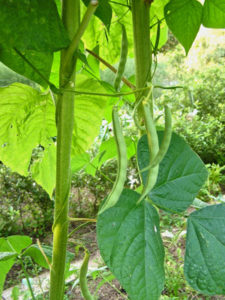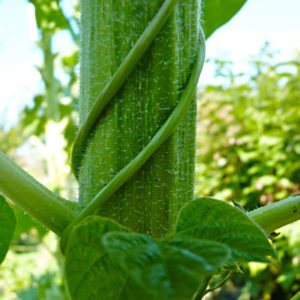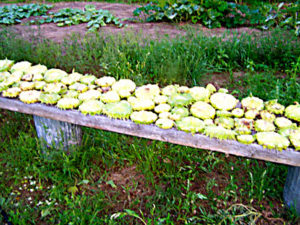 |
| Pole beans growing up sunflower stalks. English photo. |
By Will Bonsall
I’m amazed that so many gardeners plant a row of sunflowers along the edge of their garden to feed the birds. What amazes me is that they plant only for the birds (and perhaps for a windbreak on the north side) and that they plant only a row rather than a whole block – not just for birds, but for themselves to eat.
Of course, the branching ornamental sunflower varieties are most often grown, in which case a single row makes sense, since they are good only for show and for feeding insects. However, other types are both ornamental and more useful – perhaps not as ornamental as the cut-flower types, but so nutrient-packed that a compromise might be warranted, or both types might be grown, each in its own place for its own purpose.
Sunflowers are one of a handful of popular food crops native to the United States; other New World crops (corn, beans, pumpkins, tomatoes, etc.) were brought here from Central and South America. In fact, wild sunflowers are common today throughout the prairie states, often found along roadsides and irrigation ditches. It is difficult to say which are truly “wild” or merely “feral,” that is, gone wild from cultivation; both happen, and both cross-pollinate freely.
De-Hulling and Pressing Sunflower Seeds
Note that two types of food sunflowers exist: the large-seeded “confection” types, often with grey or white stripes, and the smaller black oilseed types, also sold as birdseed. In our early years, we aspired to grow and press our own vegetable oil, so we planted the only kind we knew – from the health food store – unaware of a difference. At first they were useless to us anyway, since we had no way to press (even if they were the wild-type) and no way to de-hull the seeds for eating whole. The latter problem was resolved when Rob Johnston let us use his CeCoCo rice huller, which does several other tricks, too. (The huller is sold by Central Commercial Company, Chuo Boeki Goshi Kaisha, P.O. Box 8, Ibaraki City, Osaka, Japan. See more at https://villageearth.org/pages/sourcebook/agricultural-tools#sthash.AmhovEY0.dpuf. Neither Rob nor I have ever used it for hulling rice.)
Borrowing Rob’s de-huller won’t work for everyone, nor is it wholly convenient for me, so I have long searched for a simple way to process seeds at home. Online accounts of using certain grain mills (including small hand-operated models) to remove hulls at a coarse setting all seem to involve stone burrs. I’ve tinkered with my Corona with steel burr plates with little luck.
 |
| Close-up of beans twining around sunflower stalks. English photo. |
Perhaps a number of Maine gardeners might pool the cost of a CeCoCo and share it, possibly at the Common Ground Country Fair. It would be marvelous for demos during the Fair, although most sunflowers are just maturing then and require another week or two to “cure” so that they’re dry enough to process. We could store the current year’s crop in rodent-proof containers until the following Fair, or have a special day in early November when folks gather for a de-hulling bee. But before we can even contemplate any such options, we have to grow the seeds.
Growing Sunflowers
We used to grow all our sunflower seeds in blocks, as we grow corn: 3 feet between rows and a foot or so between plants in the row. Since these plots were mainly on our east-west terraces, they often “lodged” or were wind-thrown, especially as the maturing heads grew top-heavy.
I thought that if aisles ran in both directions, the wind might pass through more harmlessly, so I tried planting in hills like Native corn-planters – in this case 3 feet between hills in either direction with 3 plants per hill. This alleviated the wind problem well enough but created a new problem: Crowding the plants in a cluster caused them to grow out away from each other so that the leaning, rather than the wind, caused many to fall over.
So what if I used a pole for a central support? I immediately answered myself: But sunflowers are poles; why not simply loop some twine around them so that they can support each other? I tried that for a year with some success when the obvious occurred to me: Why not grow food-producing “twine” on the sunflowers – pole beans, of course, a bit like the Native custom of beans on field corn? The only caveat was that sunflowers, which are cold-hardy and require a long season, should be planted in early May, while pole beans must wait until after the danger of frost has passed – late May to early June for me, in western Maine. That two- to three-week delay turns out to be perfect: If you could plant both at the same time, the beans would pop up and be searching for something to climb before the sunflowers had gotten established enough to support them.
By the way, I no longer direct seed sunflowers but start them in cells, thinning to three per 2-inch cell, so that I needn’t wonder whether birds will eat them. When the transplanted sunnies are about a foot tall, I poke three to five bean seeds among the plants in the hill. The “hill” is not an actual hill at this point; the first hoeing to bury tiny weeds forms the slight mound. Perhaps “cluster” is a more precise term.
 |
| Sunflower heads drying for a couple of days to loosen the seeds for screening. Photo by Will Bonsall. |
Sunflowers like moderately fertile soil, but they especially crave potassium. In fact excess nitrogen in proportion to potassium promotes tall, weak stalks that break easily. I throw a double fistful of stove-ash in each hill.
I am not content to grow only two crops on this space; I insist on growing a third – a non-food crop that will more than replenish any nitrogen the crop removes. After hilling the clusters, say in early July, I sow ladino clover over the entire piece, but especially between the hills. It doesn’t thrive in the gathering shade of the growing crops; at best it strikes root and hunkers down, establishing itself until the sunflower and bean crops are removed and the clover has the place to itself. It makes rapid and significant but modest growth in the remaining weeks of the season – but does not have enough time for the nitrogen-fixing bacteria to do their work. If I let the clover overwinter, it rebounds in spring and makes more substantial growth then, until I till it in for a June-planted crop, such as tomatoes. No need to add fertilizer then; the plot has grown its own.
Harvest
To minimize feeding by birds (blue jays and chickadees mostly), I watch the maturing heads closely. As soon as I noticed damage, I cut heads that have begun to turn yellow. This can take three or more passes if they ripen unevenly.
In addition to foiling the pesky birds, harvesting promptly at maturity also breaks the cycle of the banded sunflower moth, whose pink to green larvae eat the seeds and leave little holes in the hulls as they emerge. The trick is to cut the heads when they are just mature enough (turning yellow) but before the larvae crawl out and drop to the ground, where they can build up their numbers for next year. Also, promptly shredding the stalks in my chipper/shredder helps control borers, as it does with corn.
I place the heads face-down on a long hog-wire rack resting on trash cans and let them dry for a couple of days in the sun (no longer, or the chickadees will start in on the underside) until the seeds become a little loose, like scurvy teeth. I then lay a square of half-inch wire mesh over a trashcan and rub the heads over it; the seeds come off easily. They are still not dry enough for storage, so I winnow most of the trash in a breeze and spread the seeds on screen drying racks (metal screen is OK in this case) for several days indoors. Then they go into metal trashcans until I can de-hull them.
That gives us the large nutty seeds we love to toast and snack on (plus plenty of other uses, which I detail in my new book, Gardens Without Borders). As for pressing our own vegetable oil, I’ll discuss that in a later article.
About the author: Will Bonsall lives in Industry, Maine, where he directs Scatterseed Project, a seed saving enterprise. His book, Gardens Without Borders, will be published by Chelsea Green and is due out this fall. You can contact Will at [email protected].
